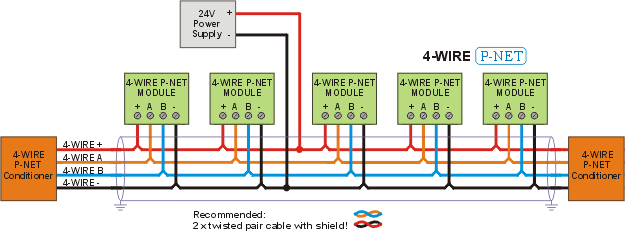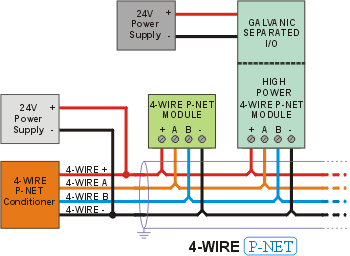4-Wire P-NET power supply
One single 24V DC power supply is used for each bus segment.
0V at the power supply is connected to ground.
The power supply can be connected at any point on a 4-WIRE P-NET bus segment.
4-WIRE P-NET with power supply

Connecting the power supply to the middle of the cable reduces the current in the power pair and minimizes the voltage drop along the bus cable.
4-WIRE P-NET with power supply

The power pair of the 4-WIRE P-NET must always be isolated from ground. It is not permitted to connect bus power supply “–“ to ground at any point other than at the power supply unit.
For any field device (valves, transmitters etc.) powered from the bus, it must be ensured that the power supply is isolated from ground. The housing of the field device may be connected to ground, to ensure a good earth connection to the cable screen.
It is usually only low power devices that are powered from a 4-WIRE P-NET bus.
Devices with high power consumption should be powered from a local source, not from the 4-WIRE P-NET bus.
4-WIRE P-NET considerations for high power devices
If the connected device has a large number of I/O or has high power consumption, it is not very desirable to use the bus for the supply of power. If the I/O count gets too high the possibility exists of coupling noise from the devices to the bus power pair, which could then interfere with communication. If the power consumption becomes high, this could lead to a high current in the bus cable and thus a high voltage drop, which again may lead to too low a voltage for the devices to operate. An alternative is to increase the cross-sectional area of the bus cable, the advantage of which may be out-weighed by higher costs.
Devices that switch output on and off with a high current and/or high frequency should also be avoided from being powered from the bus, because the changes in current in the power pair may interfere with communication due to voltage potential variations.
4-WIRE P-NET device with local power supply





